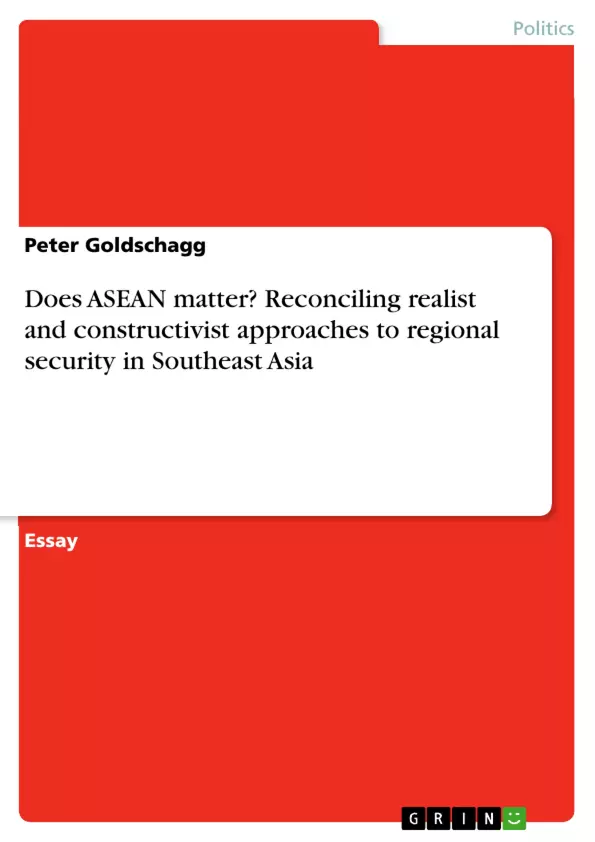Focusing on ASEAN’s relevance as a regional security organisation, this study aims to expound the prevailing driving forces, interests and obstacles to an effective crisis management.
Drawing on the theoretical background of neo-realist and constructivist approaches, the paper argues that neither the neo-realist nor the constructivist approach is able to fully conceptualise ASEAN’s role in regional security.
While only an eclectic, multi-dimensional approach grasps the variety of its multiple facets, the latter seems to be highly contingent on the interplay of external structural and internal sociological dynamics. While the organisation appears in this out sketched context as a relatively important player in times of political and economic stability, having its merits in conflict-preventive measures through the building of trust and the construction of a common identity, the regime shows strong enervations in times of crisis.
Inhaltsverzeichnis (Table of Contents)
- I. Introduction: Conceptualising ASEAN
- 2.1 ASEAN in theoretical perspective
- 2.2 ASEAN as a powerless imitation community: The Neo-realist perspective
- 2.2 ASEAN as an "emergent security community": The Social Constructivist Perspective
- III. ASEAN's role in regional conflicts
- 3.1 ASEAN's emerging role in intra-regional security in the Cold War Context: The lessons from Konfrontasi
- 3.2 ASEAN's role in extra-regional conflict management in the Cold War context: The Cambodian conflict
- 3.3 ASEAN's intra-regional security role in the Post-Cold War context: The South China Sea disputes
- IV. Concluding Remarks
Zielsetzung und Themenschwerpunkte (Objectives and Key Themes)
This study aims to examine ASEAN's effectiveness as a regional security organization, focusing on the driving forces, interests, and obstacles to effective crisis management. By drawing on neo-realist and constructivist perspectives, the paper argues that neither approach fully captures ASEAN's role in regional security. The study explores the interplay of external and internal dynamics and assesses ASEAN's strengths and weaknesses in times of stability and crisis. Here are some key themes explored in the text:- The role of regional security institutions in a system characterized by anarchy
- The influence of neo-realist and constructivist perspectives on understanding ASEAN's role
- ASEAN's successes and limitations in managing intra- and extra-regional conflicts
- The impact of external and internal factors on ASEAN's effectiveness
- The importance of building trust and common identity in fostering regional stability
Zusammenfassung der Kapitel (Chapter Summaries)
- I. Introduction: Conceptualising ASEAN: This chapter introduces the debate between neo-realism and constructivism in international relations and their differing views on the role of institutions in regional security. It highlights the contrasting perspectives on ASEAN's character and role in Southeast Asia's security architecture, with neo-realists viewing it as a powerless imitation community and constructivists seeing it as a nascent security community.
- III. ASEAN's role in regional conflicts: This chapter examines ASEAN's performance in managing intra- and extra-regional conflicts, drawing on three case studies: the Konfrontasi, the Cambodian conflict, and the South China Sea disputes. It explores the challenges and opportunities faced by ASEAN in navigating complex security scenarios.
Schlüsselwörter (Keywords)
The study focuses on the role of regional security institutions, particularly ASEAN, within the theoretical frameworks of neo-realism and constructivism. Key concepts include regional security, crisis management, balance of power, security community, inter-subjective interactions, and the interplay of external and internal dynamics in shaping ASEAN's effectiveness.- Quote paper
- Peter Goldschagg (Author), 2007, Does ASEAN matter? Reconciling realist and constructivist approaches to regional security in Southeast Asia , Munich, GRIN Verlag, https://www.grin.com/document/73838



